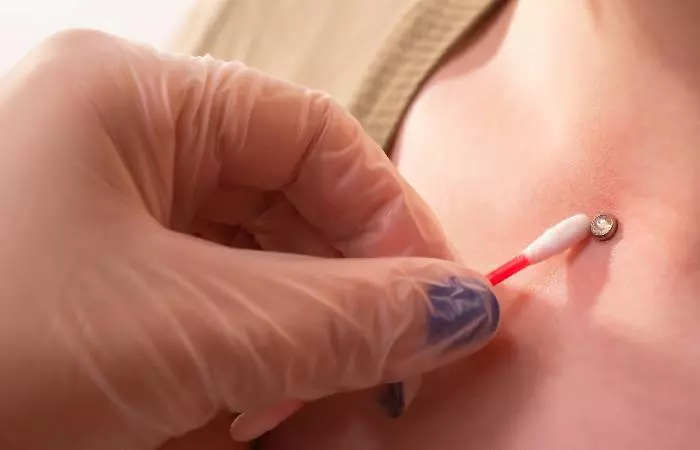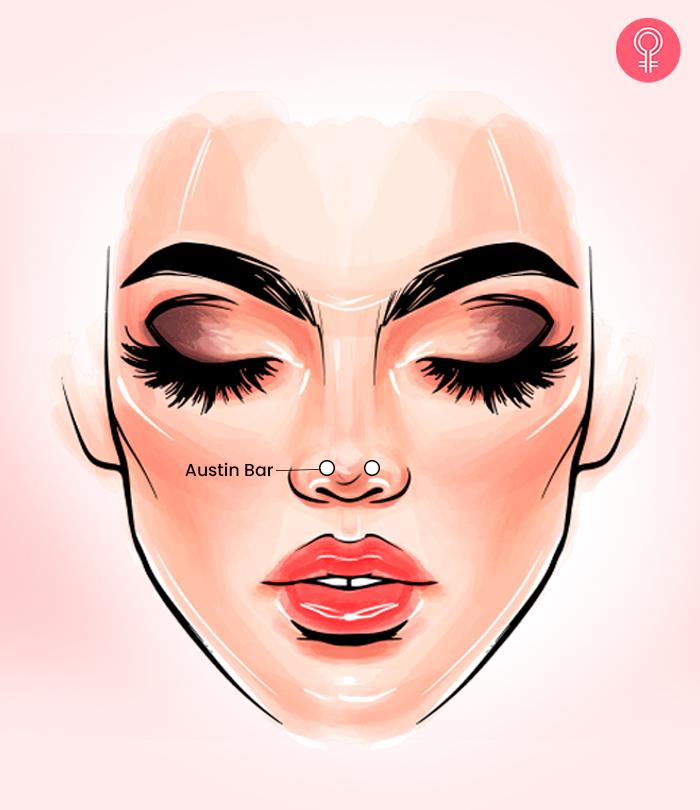When To Consider Dermal Piercing Removal And How It Is Done
Discover essential information and tips for a smooth and safe piercing removal experience.

Image: iStock
Dermal piercings have become popular due to their minimalist aesthetic. They involve creating a hole in the skin and inserting a dermal anchor of 6 to 7 millimeters into the dermis (middle layer of skin) to hold the adornment in place. However, incorrect placement or an infection may push some people to opt for dermal piercing removal. This might make you wonder if it is a safe, simple, and quick procedure or not. But fret not. We have got you covered. In this article, we will delve deep into what the procedure is like, important facts to know before opting for removal, some essential aftercare instructions, and more. Scroll down to know more.
In This Article
Can Dermal Piercings Be Removed?
Yes, dermal piercings can be removed. While they are a unique and subtle way of expressing oneself, removing them is always an option if your tastes or ideals change over time. The good news is that the removal process is generally safer and less painful than the initial piercing process. There is a reduced risk of infection because the microdermal anchor lies underneath the skin and the skin tissues are relatively easy to close. However, it is important to get them done with professional piercers instead of removing them by yourself.
 Trivia
TriviaMany might opt for a dermal piercing removal for various reasons. Find out what they are in the section below.
Reasons For Removing Dermal Piercings
The decision to part with a dermal piercing is not an easy one. However, the reasons given below may push one to consider the removal of dermal piercings:
- Dermal piercings are more prone to skin infection due to neglected hygiene or improper placement by an inexperienced piercer.
- The body may reject the piercing and try to push it out of the skin, resulting in scarring and other complications.
- Some individuals may experience slow due to an allergic reaction to the jewelry material such as nickel (1).
- Piercing does not fit your current style or life choices anymore.
- Certain professions may have restrictions against visible piercings.
- Medical treatment or procedures such as MRIs may require removing dermal piercings to avoid complications (2).
- Dermal piercings can sometimes snag on clothing or hair, causing irritation and discomfort.
- Some women remove dermal piercings during pregnancy due to concerns regarding their baby’s safety and health (3).
- Persistent discomfort, irritation, or sensitivity around the dermal piercing site.
Kristina, a blogger, shares her microdermal piercing experience and how she had to ultimately remove it due to her body rejecting it. She writes, “As much as I really wanted it to work as I loved it dearly.. My skin was just not wanting it no matter what. I would’ve think the second time would’ve work better than that, as the piercer I got was way more trustful and professional than the first one did – but you cannot go against the body’s will. (i).”
An allergic reaction or an infection may push you to get a dermal piercing removal. But before you do so, here are some essential factors you need to keep in mind to ensure a smooth and safe experience. Scroll down to the next section to find out.
Things To Know Before Getting A Dermal Piercing Removed
If you have decided to part ways with your dermal piercing, here are some crucial things to keep in mind before diving headfirst into its removal:
- Always consult a reputable piercer and never attempt to do it on your own as it may cause irreversible damage.
- Wait until the dermal piercing has fully healed before attempting removal to lessen the risk of complications.
- In some cases, a tiny skin incision might be necessary to access the anchor, especially for stubborn or older piercings.
- You may experience some redness and swelling after the removal.
- Although minimally invasive, scar tissue or formation is always a possibility.
- If you have any upcoming events where you want your piercing-free area to be visible, plan your removal accordingly.
It is important to consult your piercer or doctor to understand the pros and cons before going for the removal process.
The points mentioned above will help ensure you have a smooth and safe piercing removal experience. Check out the next section to get a better understanding of how it works.
How To Remove A Dermal Piercing
Removing a dermal piercing is a precise and careful process that prioritizes safety, minimal discomfort, and quick healing. The process is as follows:
- Choose a reputable piercer or an experienced doctor to help assess your piercing depth and discuss the best approach.
- They will cleanse the area around the piercing with an antiseptic solution and pat dry the area with a gauze.
- A local anesthetic is often applied to numb the area and minimize discomfort during the procedure
- The visible part of the dermal jewelry is unscrewed and the anchor is dislodged by massaging the area around it.
- A tiny incision or hole is made around the anchor with a scalpel.
- The anchor is extracted with a pair of forceps.
- An antibiotic cream and a bandage are applied to let the wound heal.
The dermal piercing removal is quick and smooth. However, following the instructions given by your piercer or doctor will reduce the risk of skin infection and scarring. Find out more about them in the section below.
Dermal Piercing Removal: Aftercare Tips
After the dermal piercing removal, proper aftercare is essential to promote healing and minimize the risk of complications. Here are some tips you can follow (4), (5):
- Gently wash the area with a mild, antibacterial soap and lukewarm water.
- Always pat dry with a clean, sterile gauze pad.
- Avoid harsh products and vigorous scrubbing.
- Use a saline solution soak twice a day to promote healing and prevent crusting.
- Refrain from touching the area to avoid introducing bacteria to the healing wound.
- Avoid over-bandaging as it can trap moisture and bacteria.
- Avoid swimming, hot tubs, and other water bodies for at least the first week to give the wound time to close.
- Use an antibiotic ointment given by your piercer.
- Look for excessive or worsening symptoms like extreme swelling, throbbing pain, or pus discharge and get immediate medical attention.
- Schedule a follow-up appointment with your piercer in a week or two to see if you are on track with your healing.
- Avoid strenuous activities or excessive sweating for a few days to allow the removal site to heal properly.
 Quick Tip
Quick TipThe instructions given above will help speed up your healing process and get you sporting that pierce-free zone in no time!
Dermal piercings are a rage among newbies and enthusiasts alike due to their subtle sparkle and understated elegance. However, incorrect placement, a change in aesthetic preferences, or an infection may force you to bid goodbye to your dermal piercings. As you navigate this transition, remember to choose a reputable piercer or doctor and practice meticulous aftercare. With proper care and a touch of patience, the removal process can be smooth, safe, and swift.
Frequently Asked Questions
How to remove dermal piercings at home?
Removing a dermal piercing at home can be very dangerous and is strongly discouraged. It is a delicate procedure that should be performed by a trained professional, such as a piercer or a doctor in sterile conditions. Attempting removal yourself increases the risk of infection and significant scarring.
How painful is it to remove a dermal piercing?
Dermal piercing removal is generally less painful than the initial piercing process due to the absence of tissue piercing. Local anesthesia is typically used to minimize discomfort experienced during the process. However, it is important to understand that pain tolerance differs from person to person.
Key Takeaways
- Dermal piercings, also known as micro-dermal or single-point piercings, involve inserting a singular piece of jewelry with a dermal anchor beneath the skin.
- Evolution in style, workplace regulations, pregnancy, or allergic reactions are some common reasons why individuals may choose to remove dermal piercings.
- Choosing a reputable piercer or doctor with the necessary skills is essential for a safe and smooth removal process.
- Cleaning your wound twice daily and applying the antibiotic ointment recommended by the expert will help ensure a speedy recovery.
It is important to understand the concept of microdermal anchors before going for a dermal piercing. Check out this video for important insights on placement, healing, and more to help you make an informed decision.
Personal Experience: Source
StyleCraze's articles are interwoven with authentic personal narratives that provide depth and resonance to our content. Below are the sources of the personal accounts referenced in this article.
(i) Microdermal piercings; My experience/story
https://books-and-dachshunds.com/microdermal-piercings-my-experience-story/
References
Articles on StyleCraze are backed by verified information from peer-reviewed and academic research papers, reputed organizations, research institutions, and medical associations to ensure accuracy and relevance. Read our editorial policy to learn more.
- Magnetic Resonance Imaging Contraindications
https://www.ncbi.nlm.nih.gov/books/NBK551669/ - Piercings in medical students and their effects on the skin
https://www.ncbi.nlm.nih.gov/pmc/articles/PMC4230659/ - Nickel Allergic Contact Dermatitis: Identification, Treatment, and Prevention
https://www.researchgate.net/publication/340959429_Nickel_Allergic_Contact_Dermatitis_Identification_Treatment_and_Prevention - CARING FOR NEW PIERCINGS
https://www.aad.org/public/everyday-care/skin-care-basics/tattoos/caring-for-pierced-ears - SUGGESTED AFTERCARE FOR BODY PIERCINGS
https://safepiercing.org/aftercare/
Read full bio of Eshna Das
Read full bio of Shreya Mukherjee




























